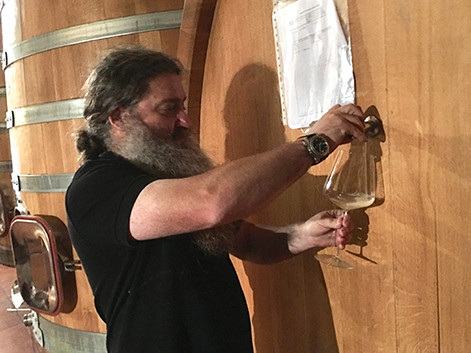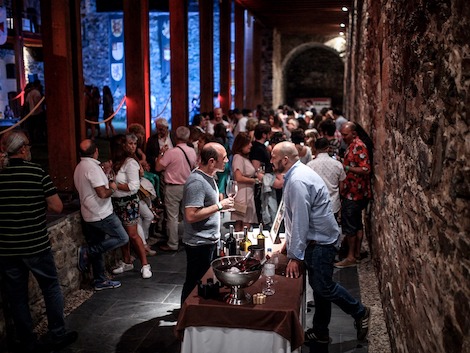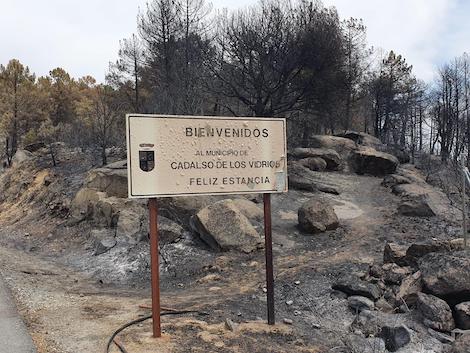
In all fields, the stature of a professional is measured by their achievements and their ability to both influence and set trends. In the world of wine, the emotional impact of certain special wines should also be considered.
Winemaker Raúl Pérez is highly revered by the new generation of Spanish producers. He is a major influence in Bierzo, his native region, and in Galicia, where he has set new quality standards in Rías Baixas and Ribeira Sacra. He also consults for wineries in other parts of Spain. Although his wines are at time irregular and undergo frequent changes, they manage to deliver unique and memorable experiences. And, best of all: prices have remained very reasonable.
Raúl Pérez could not be further away from the clichéd image of a wine celebrity. Behind the prophet-like beard he keeps these days, there is the brilliant and chaotic mind of a man of limitless generosity. In Spain, he was one of the first winemakers to start talking frankly about how he made his wines.
Pérez cannot be reached via Whatsapp, never answers emails, and rarely picks up the phone. But when he devotes his time to someone, he engages fully. The doors of his winery have always been wide open to a crowd of newcomers to the region. Prominent names like Álvaro Palacios and his nephew Ricardo Pérez or Cádiz-born Verónica Ortega did their first fermentations there. Now, he hosts the wines of producers like Diego Magaña, Marcial Dorado from Galicia and of foreign winemakers (and friends) such as Argentine partners Gerardo Michelini and Andrea Mufatto, Portugal's Dirk Niepoort and France's Antoine Graillot.
“What matters is people,” says Pérez. “Projects succeed when people are good and fall when they are not. It's hard to fail if there are good vibes.”
His work as consultant has helped him develop great friendships with producers like Rodrigo Méndez (Forjas del Salnés, Rías Baixas), who wanted to make reds in a white wine region. Raúl helped him in exchange for Albariño grapes to make his very own own (thus Sketch was born). Today, they are vey close and work hand in glove in Castro Candaz, a joint project in Ribeira Sacra.
We’ll always have Valtuille
Although he travels extensively, Raúl Pérez's heart is rooted in Bierzo. Born in Valtuille de Abajo, the village with the largest surface under vine in the region, he began producing wine in Castro Ventosa, his family's winery. He now lives in his native village, in a house he built in the middle of the vineyards.
While driving along winding roads, he points out boundary lines between plots and sites that are hardly easy to see for the newcomer. To the right, La Poulosa's hot clay; to the left, Villegas' distinctive sandy soils that mark the style of Ultreia Valtuille, but, he warns, "a step further down yields rise significantly."
Villegas, formerly his favorite plot, feels rather warm based on today's standards. "At the end of the 1990s, I thought sand was the most suitable soil, but regardless of what I think now, wines still reflect the vineyards they come from,” he acknowledges. “I have seen wines made in different styles converging 15 to 20 years later; in the end, the terroir always comes through and good plots make good wines."
He is certain that there are almost a dozen significant sites in Valtuille. In addition to Villegas, La Vitoriana ("a semi-abandoned area with five or six owners and four to five hectares"), La Claudina and particularly El Rapolao, where he has just bought seven tiny pieces of land to plant. This is a cooler, steeper slope with clay-ferrous soils that seems more suitable for the delicate style of 21st century wines.
Following the Burgundian model, there are several wines born from El Rapolao and made by Raúl himself (in his ranges La Vizcaína and Ultreia and under his own name for an ultralight version made with grapes sourced from the highest vines), his family (Castro Ventosa and his nephew César Márquez) and friends (Diego Magaña, Michelini & Mufatto).
Saint Jaques, Ponferrada and Viariz
“Until now the priority was to safeguard the plots and keep them as independent wines,” explained Raul. “Now it’s the time to make them profitable so the rest is viable.”
That's why he's building a new 400,000-litre winery for his entry-level red wine Ultreia Saint Jacques. Expansion has been backed up by the arrival of new investors at Bodegas y Viñedos Raúl Pérez, including US-based chef José Andrés.
This move could bring Ultreia Saint Jacques (around 130,000 bottles produced) closer to Pétalos del Bierzo (Descendientes de J. Palacios), which exceeds 300,000 bottles. And in doing so, it would establish an unusual situation for Spanish DOs with quality-driven producers becoming also major players in terms of volume.
The expansion involves two more projects in very specific areas of Bierzo, but quite distant from each other.
The most recent explores Viariz, a small hamlet up in the mountains in Corullón, along the road behind the new winery of Descendientes de J. Palacios —in fact, the vineyards were purchased from Álvaro Palacios and Ricardo Pérez. This is a remote area at high elevation (up to 1,045 metres) with small plots perched on steep slopes on clay and slate soils. The wines will be vinified for the first time this coming harvest at La Vizcaína winery in Valtuille.
In this adventure, Raúl and his new partners have joined Spanish businessman Alfonso Carrascosa. Founder of legal advice company Legalitas, Carrascosa is also an enthusiastic wine collector who may have soon his own Rapolao.
The project in Valdecañadas (Ponferrada) started in the 2014 vintage but struggled to continue in 2016 and 2017 due to mildew and frost respectively. In 2008, Raúl started buying and recovering vineyards in this area —one that has never seen again the glory days before phylloxera. They now grow eight hectares here. While altitude is also remarkable (600 to 840 metres), soils have a high presence of slate.
Four limited production single-vineyard wines are set to be released after the summer. Until recently, most of these wines ended up in the generic red Ultreia or in Petra, which is also part of the Ultreia range and was first released in the 2012 vintage. Raúl has great hope in this area’s north-facing vineyards to make fine, supple reds with higher acidity that may need longer ageing times.
Bierzo wines under a veil of flor
These new wines are aged in an ancient winery in Salas de los Barrios, a hamlet of Ponferrada, together with Ultreia’s premium and single-vineyard wines.
Behind its majestic stone walls, you breathe monastic peace. It is a stark contrast with all the messy hustle and bustle in the Valtuille winery where La Vizcaína range and part of Ultreia Saint Jacques are made. The building, erected by the Church in 1819, used to store the levy destined to Astorga’s dioceses. The upper level was used to store cereal and fruit whereas grapes occupied the lower level.
The most interesting thing about this place is out of sight though. The winery is "contaminated" by flor (yeasts). It seems to be a direct result of whole bunch fermentation and very long vattings. Many berries remain unbroken so they still retain sugar. As the wine is pressed and then put into barrels and periodic refills are avoided, a veil of yeasts is formed. This layer of flor can go through different states of thickness — it was barely present during our visit as it can be seen in the photo above).
Raúl didn’t seek to have flor, yet it is positive. “Yeasts capture the oxygen and eliminate reduction so they naturally protect wine.” Yeasts also help him to do away with sulphur (“with sulphur, oxygen dissolution is lower, so in its absence tannins polymerize faster”) and to extend ageing times despite Pérez is increasingly questioning ageing times in oak.
A sworn enemy of technique, Pérez often points out that “everything has been invented in winemaking” and that his goal is to “keep things as simple as posible”. For him, the most important issue for any winemaker is to find their very own style.
Apart from flor yeasts, he favours early harvesting, whole bunch fermentation (even if stems are bright green!) and vatting for several months —things that would make most winemakers feel uneasy. “I’ve tried to recall how wine was made by my family in the past and now I understand better why they worked the way they did: they used to stomp grapes that were fermented spontaneously and press after Christmas”. He firmly believes that this is the best way to express the terroir. Is this not an interventionist approach like many others? “Maybe so, but once the wines enter the cellar, our work is minimal. We extract tannins is a most respectful way; it is simply a process that needs time,” he adds.
Last year Raúl Pérez took part in a tasting of top Spanish wines held at the IMW symposium in Logroño alongside Gramona, Vega Sicilia, Descendientes de J. Palacios, Tondonia, Dominio de Pingus and Toro Albalá. When it was over, an MW and winemaker reluctantly reckoned (he just didn’t want to fall in love with a wine made in such an unorthodox fashion) that the Ultreia Valtuille 2014 had been his favourite in the flight. Raul’s most brilliant wines usually cause this impression.
A guide to the many wines made by Raúl Pérez
This is a compilation of the various projects and wines in which this producer has left his mark. It’s not meant to be a close list —Raúl Pérez is a restless winemaker and is always busy with new projects; we will do our best to keep it updated. All the wines that are no longer made have been left out of this list.
Castro Ventosa (Bierzo). Raúl Pérez has been at the helm of his family’s winery at different stages of his career. His nephew César Márquez, who worked with him at La Vizcaína until 2016, is now in charge but Raúl continues to help out with blends. The main brands are El Castro de Valtuille (the range includes a white wine and two reds, one young and one aged in oak) and Valtuille Cepas Centenarias. Single-vineyard reds include El Rapolao, La Cova de la Raposa and Villegas.
La Vizcaína (Bierzo). Wines from traditional, over 50-year-old vineyards from Valtuille de Abajo made in a winery in this village. Most of the plots are small, no bigger than one or two hectares at most. The range includes three single-vineyard reds, Las Gundiñas, La Poulosa and El Rapolao, and the white La del Vivo. The words “Lomas de Valtuille” (slopes in Valtuille) are printed on their labels. Grapes are sourced from six or seven hectares and production ranges from 20,000 to 28,000 bottles.
Ultreia (Bierzo and beyond). This was Raúl’s first venture on his own. Ultreia is the Latin term used by pilgrims to greet each other on the Camino de Santiago and means proceed! It encompasses a large range of wines including a couple made in other countries.
The entry-level Ultreia Saint Jacques is an affordable, floral, easy-to-drink Mencía made in Raúl’s trademark winemaking style. Other wines are Ultreia (around 5,000 bottles), a generic red made with grapes grown in Valtuille, a single-varietal white Godello (7,000 bottles) and a large range of single-vineyard wines. Grapes for the white Ultreia La Claudina and the reds Ultreia Valtuille (from Villegas vineyard), Ultreia El Rapolao and Ultreia Cova de la Raposa are also sourced from Valtuille.
Grapes for Ultreia de Paluezas are sourced from San Juan de Paluezas, 30 kilometres southeast of Valtuille. The village is very close to the ancient Roman mines of Las Médulas where some limestone soils, very unusual in Bierzo, can be found. Finally, Ultreia Petra comes from Valdecañadas in Ponferrada further east, an area at higher elevation and distinctive schist soils.
Grapes for the affordable La Clave (around €10, 50% of the wine is fermented and aged in stainless steel tanks) are also sourced from Ponferrada. This brand is sold locally and a small part is exported.
La Tentación is a rare Pinot Noir from Las Gudiñas vineyard with no appellation seal. It hasn’t been released for a while but there is a single barrel in the 2018 vintage which I had the chance to taste. Production has never exceeded three barrels. It undergoes extremely short vatting times for Pérez’s standards.
Outside Spain, Raúl makes the red Ultreia Douro at Dirk Niepoort’s winery in Portugal and the single-varietal Monastrell Ultreia Cabo de las Tormentas at Eben Sadie’s in South Africa.
More wines from León. The land of Prieto Picudo falls naturally under Raul’s area of influence. Los Arrotos del Perdón bears the winemaking hallmarks of Raúl Pérez in contrast with the extractive style widely found across the region. He also produces the single-vineyard Albarín white from a plot in Viñamañán under the brand Raúl Pérez.
Castro Candaz (Ribeira Sacra). A joint project with Rodrigo Méndez (Forjas del Salnés, Rías Baixas) in Chantada, a cooler subarea of Ribeira Sacra. Some 15,000 bottles are produced for the entry-level Castro Candaz and two single-vineyard reds: Castro Candaz A Boca do Demo and Castro Candaz Finca El Curvado. Although they started with shorter vatting times, the style is gradually moving closer to Bierzo’s. The white La Vertical, released only in the 2013 vintage, may be pursued in the future.
Other wines from Galicia. Following his work with Rodrigo Méndez in Salnés (Rías Bixas), Raúl launched Sketch in the mid 2000s. The wine is no longer part of the appellation. A small number of bottles is still aged underwater. To increase the availably of his Albariños, Raúl launched Atalier, a new brand in DO Rías Baixas. Grapes are picked ripe to keep malic acid under check. The wines do not see malolactic fermentation and are aged in large oak containers, mostly foudres.
In Ribeira Sacra, he makes the single-vineyard reds El Pecado and La Penitencia at Guímaro. Grapes are sourced from Finca Capeliños and Finca Pombeiras —both vineyards are on schist soils. None of these wines are part of the appellation.
Gredos. A joint project with La Tintorería, Raúl’s distributors in Madrid and the go-to store to find his wines and keep abreast of his projects. They used to produce two Garnacha wines from grapes grown in Cebreros (Ávila): the entry-level Le Batard and Vino de Familia, both of which are sold outside the DO. The project has now been renamed Viñedos del Jorco and features a new range of wines including Las Cabañuelas, El Jorco, El Jorco Vino de Familia and Las Enebradas. They hope to have their own winery in time to vinify the 2019 vintage.
Consultancies. In addition to his well-known partnerships with Forjas del Salnés, Algueira and Guímaro, Raúl Pérez has helped countless projects in the past such as Bodega Margón (their best known brand is Pricum) in Los Oteros (León) and has even travelled far beyond his usual area of action to briefly advise Ca'n Xanet in Mallorca. His longest ongoing consultancy work is Bodegas Estefanía (Tilenus) in Bierzo. After its purchase by MG Wines, Raúl has extended the consultancy to other wineries in the group: Venta de la Vega (the former Bodegas Almanseñas in Almansa), Sierra Salinas (Alicante), Lavia (Bullas) and Fondillón after the acquisition of Salvador Poveda and their historic sweet Fondillones in Monóvar (Alicante).
Another recent partnership is Camino del Norte with Luis Miguel Fernández in Bierzo. Grapes are sourced from Valtuille but the wines are sold outside the DO.

Amaya Cervera
A wine journalist with almost 30 years' experience, she is the founder of the award-winning Spanish Wine Lover website. In 2023, she won the National Gastronomy Award for Gastronomic Communication
NEWSLETTER
Join our community of Spanish wine lovers






